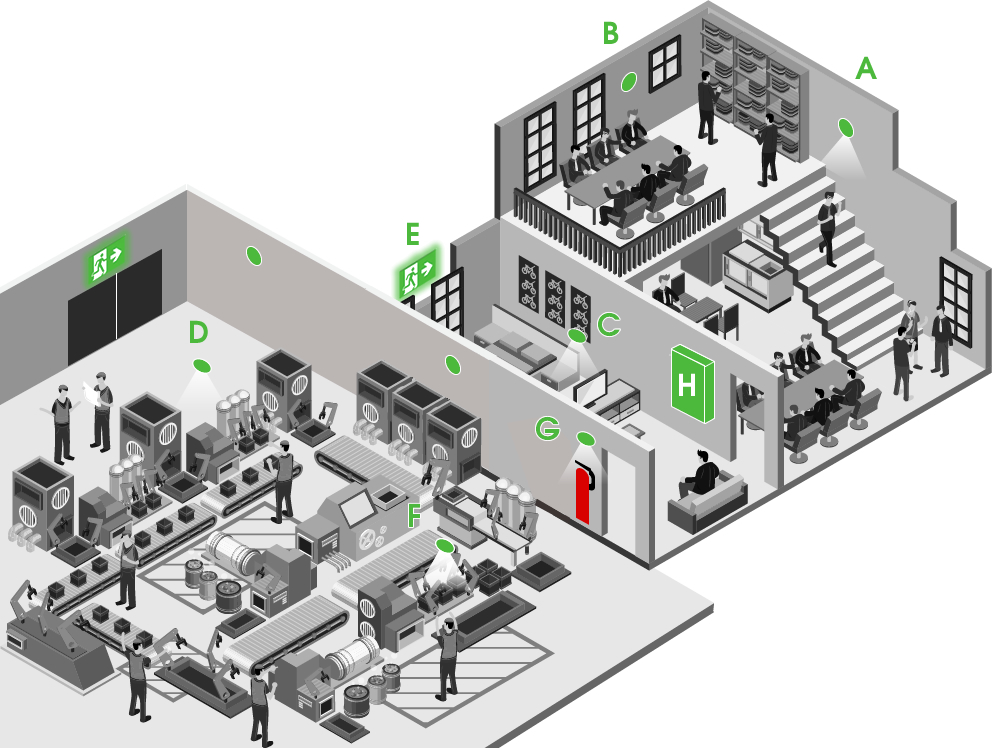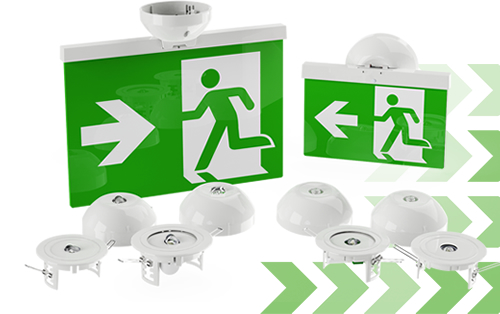Understanding Emergency Lighting Systems
Part of our educational life safety series for building owners, this article explains what an emergency lighting system is, how they work, their key features and benefits and why your building needs one.
Part of our educational life safety series for building owners, this article explains what an emergency lighting system is, how they work, their key features and benefits and why your building needs one.
Emergency lighting systems are life safety installations designed to provide illumination during power failures or emergency situations, ensuring safe evacuation routes remain visible when normal lighting fails. These systems are governed by strict European standards, particularly EN 50172 and EN 1838, which establish comprehensive requirements for design, installation, and maintenance to protect building occupants across the European Union.
For building owners, emergency lighting represents a critical life safety infrastructure that not only ensures compliance with legal requirements but also provides essential protection for occupants during crisis situations. Unlike standard lighting systems, emergency lighting operates independently of the main electrical supply, activating automatically when normal power is interrupted.

Emergency lighting has undergone significant technological advancement over recent decades. Early systems relied on basic incandescent bulbs powered by large lead-acid batteries, requiring frequent maintenance and offering limited operational life. Modern emergency lighting systems have evolved to incorporate LED technology, intelligent monitoring capabilities, and sophisticated battery management systems.
Contemporary systems feature self-testing capabilities, extended battery life, and improved energy efficiency. The introduction of LED technology has revolutionised emergency lighting by providing brighter illumination with significantly reduced power consumption, extending operational duration during emergencies while reducing maintenance requirements.
Emergency lighting systems function through a network of luminaires strategically positioned throughout buildings to ensure adequate illumination along escape routes, in high-risk areas, “points of emphasis” and in open spaces where occupants might congregate during evacuation.

Based on a centralised array of high-powered batteries that feeds multiple emergency lights throughout a building through cabling.

Comprising mains-powered luminaires and exit signs that switch to a battery back-up in the event of a power failure.

Based on lighting and other field devices, designed to be self-contained, i.e. they feature integral batteries to power the units during an emergency.
Regardless of type, these systems typically comprise several key components:
![]()
Maintained Luminaires:
Lights that operate continuously, switching to emergency power when mains supply fails.
![]()
Non-Maintained Luminaires:
Lights that activate only during emergency situations, for example, down lights.
![]()
Escape Route Luminaires:
Specific illumination designed to clearly mark evacuation paths and corridors.
![]()
Open Space Luminaires:
Wide-area illumination to prevent panic in large spaces and enable safe evacuation.

![]()
Exit Signs:
Illuminated directional signs designed to direct people to the nearest emergency exit.
![]()
High-Risk Task Area Lighting:
Specialised lighting for areas where dangerous processes might need light in order to be safely shut down.
![]()
Points of Emphasis Lighting:
Lighting is required in areas of the building that require specific items to be highlighted during a power cut, such as firefighting equipment, changes in floor level or direction, and medical stations.
![]()
Lighting Control Panel:
Modern systems incorporate intelligent control units that continuously monitor system status, automatically conduct regular testing, and provide detailed reporting on system performance. These controls can integrate with building management systems to provide centralised monitoring and maintenance scheduling.
European emergency lighting systems must comply with rigorous standards that ensure consistent performance across all member states. The primary standards include:
Emergency lighting is a requirement under the Regulatory Reform (Fire Safety) Order 2005 (RRFSO) in all non-domestic buildings and in communal areas of HMO (houses of multiple occupancy). The purpose of emergency lighting is to illuminate emergency exits and escape paths in the case of a mains power failure. Article 14 (2) (h) of the RRFSO states that
“Emergency routes and exits requiring illumination must be provided with emergency lighting of adequate intensity in the case of failure of their normal lighting”.

Establishes the requirements for emergency lighting systems, covering design principles, installation methods, and maintenance procedures. This standard defines minimum illumination levels for different areas and specifies duration requirements for emergency operation.

Provides detailed photometric requirements, specifying exact illumination levels for escape routes (minimum 1 lux), open areas (minimum 0.5 lux), and high-risk task areas (minimum 10% of normal illumination or 15 lux, whichever is greater).

Covers the requirements for automatic test systems, ensuring that emergency lighting systems can self-monitor and report their operational status without manual intervention.

A British Standard that provides a code of practice for emergency lighting in buildings. It outlines recommendations for the design, installation, and maintenance of emergency lighting systems to ensure safe evacuation during power outages or other emergencies. The standard covers various aspects, including minimum illuminance levels, safety sign placement, and the selection of appropriate system types based on the building's characteristics and risk assessment.
Visit our Literature page to download a soft copy of our own guide to BS 5266-1 booklet.

Correct understanding and adherence to these standards will ensure that emergency lighting systems provide adequate illumination for safe evacuation. Typically, these systems are required to provide a minimum three-hour duration of emergency operation, though specific requirements may vary based on building type and occupancy so check your local standards and codes of practice.

Contemporary emergency lighting systems incorporate sophisticated self-testing capabilities that automatically verify system functionality at predetermined intervals. These systems conduct functional tests (brief activation to verify operation) and duration tests (extended operation to verify battery capacity) without manual intervention, maintaining detailed logs of all test results.

Modern systems predominantly utilise LED technology, offering several advantages over traditional lighting:

Current systems feature sophisticated battery management technology that optimises charging cycles, monitors battery health, and provides early warning of battery degradation. Lithium-ion batteries are increasingly replacing traditional nickel-cadmium units, offering improved performance and reduced environmental impact.

Advanced systems can incorporate remote monitoring through cloud technology, allowing centralised monitoring of distributed emergency lighting installations. This technology enables facility managers to monitor system status, receive immediate fault notifications, and schedule maintenance activities across multiple sites, all from a central location.
Emergency lighting systems are mandatory in virtually all commercial, industrial, and public buildings in most regions, with specific requirements varying based on building classification or local standards:

Offices, retail spaces, and shopping centres require comprehensive escape route lighting and open space lighting in large areas.

Manufacturing plants and warehouses need high-risk task area lighting in addition to standard escape route illumination.

Hospitals and care homes require extended duration systems and specialised lighting for critical areas.

Schools and universities need robust systems capable of handling large numbers of occupants evacuating simultaneously.

Apartment buildings and housing complexes require escape route lighting in common areas and stairwells used for evacuation.
Effective emergency lighting design requires careful consideration of several factors:
Designers must identify all potential evacuation paths and ensure adequate illumination along each route, considering factors such as corridor width, stairwell configuration, change of floor level and exit door locations.
High-risk areas such as kitchens, plant rooms, or areas containing hazardous materials require specialised lighting solutions to ensure safe shutdown procedures can be completed during emergencies.
Buildings with high occupancy levels may require enhanced open area lighting to prevent dangerous overcrowding during evacuation.
Complex building configurations may necessitate additional emergency lighting to ensure all areas remain adequately illuminated during evacuation.
European standards mandate regular maintenance and testing of emergency lighting systems to ensure continued compliance and operational reliability. Building owners must establish maintenance schedules that include:
Modern self-testing systems significantly reduce the administrative burden of compliance by automatically conducting required tests and generating electronic records, though periodic manual verification still remains necessary.
While emergency lighting systems represent a significant capital investment, building owners should consider the total cost of ownership, including installation, ongoing maintenance, and potential liability costs. Modern LED-based systems often provide favourable return on investment through:
The emergency lighting industry continues to evolve with advancing technology. Emerging developments include dynamic signage, integration with building information modelling (BIM) systems, enhanced cloud-based communication capabilities, and improved battery technologies offering extended life and reduced environmental impact.
European emergency lighting systems represent a crucial component of building safety infrastructure, providing essential illumination to ensure safe evacuation during emergency situations. Understanding these systems enables building owners to make informed decisions about installation, maintenance, and compliance with European safety standards.
The combination of strict regulatory requirements, advanced technology, and professional installation ensures that properly designed and maintained emergency lighting systems provide reliable protection for building occupants. As with all life safety systems, consultation with qualified professionals remains essential to ensure appropriate system design and ongoing compliance with applicable standards.

This article is part of our "Hochiki On" educational Fire Safety series, designed to help building owners understand modern life safety technologies. For more information about life safety solutions, please explore our other educational resources or contact our technical support team.